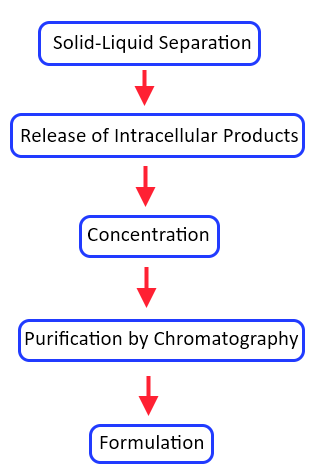
What is downstream processing?
Answer
505.5k+ views
Hint: The biosynthesized product is purified and formulated with suitable preservatives before being distributed for public use. To accomplish this, a series of processes are employed which involve various types of physical and chemical methods.
Complete answer:
By the use of techniques of biotechnology, we synthesize various types of proteins and enzymes of the desired nature. As we synthesize them with the help of microorganisms, the obtained products are not in a pure state and have many types of impurities including the different secretions from the microorganisms. For making the product suitable to use and removing unwanted materials from it, a series of procedures are followed which are collectively known as downstream processing.
Additional information:
The stages and related processes in downstream processing are as follows –

Solid-Liquid Separation – at this stage the undesired cells and other insoluble materials are removed from the culture broth by using processes like floatation, flocculation, filtration, and centrifugation.
Release of Intracellular Products – at this stage the biochemical products that are located within the cultured cells are obtained by breaking the cells using methods like ultrasonication, heat shock, high pressure, organic solvents, lysozymes, etc.
Concentration – here, using methods like membrane filtration, liquid-liquid extraction, precipitation evaporation, and adsorption, the extra amount of water present in the product is removed.
Purification by chromatography – here, the biological product is purified very precisely using chromatographic methods.
Formulation – this is the final stage and at this stage, it is made sure that the activity and stability of the desired product is maintained during the storage.
Note: After completion of the downstream processing, suitable preservatives are added to the product to ensure its storage and use for a longer time. After this, the product undergoes thorough clinical trials where its actions and effects are monitored. Following this, a strict quality control testing is done and then the product is released to be used by the public.
Complete answer:
By the use of techniques of biotechnology, we synthesize various types of proteins and enzymes of the desired nature. As we synthesize them with the help of microorganisms, the obtained products are not in a pure state and have many types of impurities including the different secretions from the microorganisms. For making the product suitable to use and removing unwanted materials from it, a series of procedures are followed which are collectively known as downstream processing.
Additional information:
The stages and related processes in downstream processing are as follows –

Solid-Liquid Separation – at this stage the undesired cells and other insoluble materials are removed from the culture broth by using processes like floatation, flocculation, filtration, and centrifugation.
Release of Intracellular Products – at this stage the biochemical products that are located within the cultured cells are obtained by breaking the cells using methods like ultrasonication, heat shock, high pressure, organic solvents, lysozymes, etc.
Concentration – here, using methods like membrane filtration, liquid-liquid extraction, precipitation evaporation, and adsorption, the extra amount of water present in the product is removed.
Purification by chromatography – here, the biological product is purified very precisely using chromatographic methods.
Formulation – this is the final stage and at this stage, it is made sure that the activity and stability of the desired product is maintained during the storage.
Note: After completion of the downstream processing, suitable preservatives are added to the product to ensure its storage and use for a longer time. After this, the product undergoes thorough clinical trials where its actions and effects are monitored. Following this, a strict quality control testing is done and then the product is released to be used by the public.
Recently Updated Pages
Express the following as a fraction and simplify a class 7 maths CBSE

The length and width of a rectangle are in ratio of class 7 maths CBSE

The ratio of the income to the expenditure of a family class 7 maths CBSE

How do you write 025 million in scientific notatio class 7 maths CBSE

How do you convert 295 meters per second to kilometers class 7 maths CBSE

Write the following in Roman numerals 25819 class 7 maths CBSE

Trending doubts
Where did Netaji set up the INA headquarters A Yangon class 10 social studies CBSE

A boat goes 24 km upstream and 28 km downstream in class 10 maths CBSE

Why is there a time difference of about 5 hours between class 10 social science CBSE

The British separated Burma Myanmar from India in 1935 class 10 social science CBSE

The Equation xxx + 2 is Satisfied when x is Equal to Class 10 Maths

What are the public facilities provided by the government? Also explain each facility




